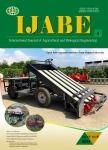Land use change characteristics affected by water saving practices in Manas River Basin,China using Landsat satellite images
作者机构:College of Water Conservancy and Architectural EngineeringShihezi UniversityShihezi 832000China Key Laboratory of Modern Water-Saving Irrigation of Xinjiang Production and Construction CorpsShihezi 832000China China Water Resources&Hydropower Science Research InstituteBeijing 100038China
出 版 物:《International Journal of Agricultural and Biological Engineering》 (国际农业与生物工程学报(英文))
年 卷 期:2017年第10卷第6期
页 面:123-133页
核心收录:
学科分类:070801[理学-固体地球物理学] 07[理学] 0708[理学-地球物理学]
基 金:We acknowledge National Key Development Program(2017YFC0404303,2017YFC0404304) the Natural Science Funds(No.41601579) Excellent Youth Teachers Program of Xinjiang Production&Construction Corps(CZ027204)
主 题:land-use change spatial characteristics influencing factor Manas River Basin Landsat satellite images
摘 要:The characteristics and influencing factors of land use change under arid conditions were studied in the Manas River Basin in Xinjiang Region,Northwest *** satellite images acquired in 1976,1990,2000,2010 and 2015 over the study area were used as basic *** use change,the rate of change of land use,land use transfer and other aspects revealed the characteristics of land use change and related factors as influenced by water conditions in the *** results showed that:(1)Over nearly 50 years,land reclamation in the Manas River Basin resulted in the rapid expansion of an artificial oasis area,and promoted the process of‘oasis urbanization’,and accelerated the development of the river basin economy.(2)In 2000,the popularization of drip irrigation under mulch technology led to the rapid growth of cultivated land and development land in the ***,the water table declined in the desert area of the lower reaches of the river basin,and the area occupied by sparse shrub forest and grassland decreased.(3)Before popularization of water-saving technology,woodland,grassland and development land transformed to cultivated land in the amounts of 93.46 km^(2),2542.93 km^(2) and 137.53 km^(2),respectively,and woodland transformed in the amount of 189.64 km^(2).After water-saving technology was popularized,woodland,grassland and development land were transformed into cultivated land in the amounts of 567.41 km^(2),1756.2 km^(2) and 37.36 km^(2),respectively.(4)The popularization of water-saving technology made the dynamic degree of cultivated land and development land more active,and further increased landscape fragmentation and landscape *** level of urbanization development,the level of economic development and the dry humidity of the basin became the main factors affecting the change of land use in the basin.



